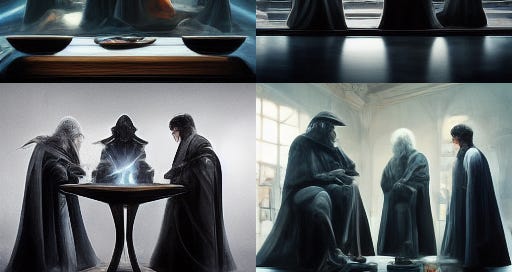The Book of Minds 5: Possibilities
The most important idea of Philip Ball’s book is that of the ‘Space of Possible Minds,’ i.e., the different ways in which one could be minded. The idea isn’t Ball’s - it comes from a paper by Aaron Sloman called ‘The structure of the space of possible minds,’ which is a very mathematical way of looking at minds. Sloman starts by recognizing that many kinds of mind are possible:
Sloman then goes on to the task of classification (of this space of possibilities):
That’s one of two spaces of possibilities we can enumerate:
If you’re a functionalist (like Sloman) about the mind (roughly, the mind is a collection of problem solving capacities, like how the function of binocular perception is to create a 3D model of the world from two 2D retinal images), then you will want to enumerate all the functions that a mind could solve in principle. For example, a bat could derive a 3D model similar to ours using sonar instead of photons. Functionally, the bat’s 3D model is close to our 3D model.
If you’re think experience is what makes a mind into a mind, then you will want to catalog the space of all possible experiences and draw similarities between them. Now comes the hard question: in what way (if at all!) is the bat’s experience of a 3D world similar to our experience of a 3D world?
Ball doesn’t explore this question, but possibility is central to the mind in a way it isn’t to matter.
Why so?
It’s because the ‘Real’ can be divided into the actual, the virtual and the possible. When we say ‘the real world’ what we typically mean is the actual world, the world made flesh in front of our eyes. But our sense of actuality quickly shades into the imagination: is the house next door to mine actual or imagined? It’s right there, so I guess its actual, but I can’t see it or touch or hear it, so in what sense do I grasp its presence?
In a real world version of Descrates’ thought experiment, the devil could come and uproot the house next door from its foundations and I would be none the wiser. The only thing that can’t be uprooted without my knowing is my own body which, for that reason, has to be the aboriginal actuality - everything else has a virtual or potential component. The universe is the biggest virtuality: a hypothetical reality that combines everything past, present and future into one big lump.
Then there’s possibility, which is related to actuality and virtuality, but is a distinct category. The house next door is virtual, but whether it has a couch or a dining table is only a possibility. I should be ready to sit on the couch or at the table if I am invited over for dinner (that’s a possibility!). My eyes should be ready to see a table and a couch and my mouth should be ready to have one of many possible conversations.
If the world was enumerable, we wouldn’t need a mind. It’s precisely because the world consists of possibilities, some of which become actual (and the actuals are surrounded by virtuals) that we need a mind.
Possibilities also make explicit the possibler, the being for whom the possibilities are real. The possibler is the constant in a world of variables, the one being who is actual in all the possible situations that constitute the world.






